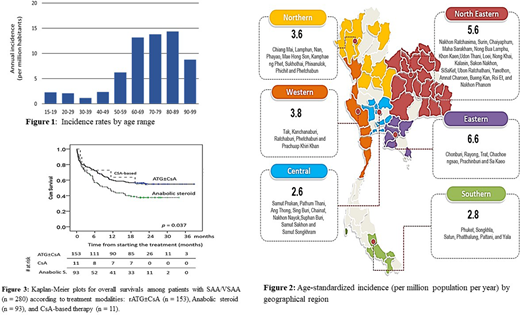Background: Incidence of Aplastic Anemia (AA) in Asia tends to be higher than in western countries, but contemporary real-world incidence and outcomes of AA in Asia remain limited. This study aimed to explore the incidence across the country regions and to evaluate the patient outcomes according to age, the severity of disease, and treatment modalities.
Method: This is a prospective multicenter nationwide population-based observational study of patients with AA aged over 15 years old, diagnosed between August 1st, 2014 to July 31st, 2016, with a longitudinal follow-up period over 2 years, from 30 medical centers. Patients with suspected hypocellular MDS and congenital bone marrow failure syndrome were excluded.
Results: During the study period of 2 years, there were 348 newly diagnosed patients with aplastic anemia, giving the annual incidence of 4.6 per million inhabitants. There was a higher annual incidence of severe (SAA) and very severe aplastic anemia (VSAA) (3.8 per million) than non-severe aplastic anemia (NSAA) (0.8 per million). The incidence was greater among older patients with a peak incidence in patients aged 60-89 years old. (Figure 1) There was a high variation in the geographic incidences across country regions, ranging from 2.6 to 6.6 per million per year. (Figure 2)
The 2-year overall survival (OS) for NSAA, SAA, and VSAA were 65.5%, 49.3%, and 20.1%, respectively (P < 0.001). Patients aged older than 60 years had the worst OS (42.6% as compared with 47.7% for the age 41-60 years and 64.5% for the age 15-40 years, P = 0.002).
Among patients with SAA and VSAA (n = 280), the overall response rate (ORR) among patients treated with rabbit anti-thymocyte globulin and/or cyclosporin A (rATG±CsA) was significantly superior than those treated with CsA-based therapy and those treated with anabolic steroid (44.4% vs. 36.4% and 31.2%, respectively, P < 0.001). Among evaluable patients, ORR after the 1st treatment with rATG±CsA at 3, 6, 12 and 24 months were 23.9%, 43.8%, 68.4% and 89.2%, respectively.
The 2-year OS among SAA/VSAA patients treated with rATG±CsA, CsA-based therapy, and anabolic steroid were 54.8%, 54.5%, and 37.6% (P = 0.037), respectively (Figure 3). From multivariate analysis, age > 60 years (HR 1.63, 95%CI, 1.14-2.33, P = 0.007), VSAA (HR 2.24, 95% CI, 1.45-3.46, P < 0.001) and not receiving immunosuppressive therapy or anabolic steroid (HR 4.96, 95%CI, 2.88-8.54, P <0.001), were independently associated with inferior OS among patients with SAA/VSAA.
Conclusion: The incidence rate of AA in Thailand from this contemporary nationwide population-based study is high, especially in the elderly. Patients treated with rATG±CsA had superior survival than those receiving anabolic steroid. The real-world outcome of patients with SAA/VSAA, especially in those aged over 60 years, is substantially poor.
No relevant conflicts of interest to declare.
Author notes
Asterisk with author names denotes non-ASH members.


This feature is available to Subscribers Only
Sign In or Create an Account Close Modal